How to Install Mastodon on Ubuntu 24.04 Server
This tutorial is going to show you how to install Mastodon on Ubuntu 24.04 server. Mastodon is an open-source decentralized social network. It’s like Twitter, but decentralized. You can set up a Mastodon instance on your server and connect to other Mastodon instances.
Mastodon Features
- Total data control. You can download all your posts and migrate to another instance.
- Never worry about account termination by a central organization.
- Each Mastodon instance can set its own rules.
- 500 character limit per post.
- Mobile-friendly, responsive web design. Users can read or post from laptop, tablet and phone.
- 100% free open source. No paid commercial version with better or more complete features.
- Official mobile apps for Mastodon are available for iOS and Android
- And many more.
Mastodon is written with React.js and Ruby on Rails, using PostgreSQL as the back-end database management system.
Prerequisites
Here’s what you should prepare before setting up your own Mastodon instance.
1. A domain name. You need a domain name, so other people can access your Mastodon instance. I registered my domain name at NameCheap because the price is low and they give whois privacy protection free for life.
2. A server. To run Mastodon, you need a server with at least 2GB RAM. If you are looking for a virtual private server (VPS), I recommend Kamatera VPS, which features:
- 30 days free trial.
- Starts at $4/month (1GB RAM)
- High-performance KVM-based VPS
- 9 data centers around the world, including the United States, Canada, UK, Germany, The Netherlands, Hong Kong, and Isreal.
- CPU and RAM hot-add. You can temporarily upgrade the server CPU and RAM for free without a reboot.
Follow the tutorial linked below to create your Linux VPS server at Kamatera.
3. SMTP Service. You need to use an SMTP server to send emails for account registration and various other notifications. You can set up your own email server (which takes some time), or use a free SMTP relay service (easier)
Once the above requirements are met, follow the steps below to install Mastodon.
Step 1: Configure PostgreSQL Database Server
Log into your server via SSH. PostgreSQL is available in the default Ubuntu repository. However, the PostgreSQL team always strives to make performance improvements with every new version, so we will install the latest version of PostgreSQL from the upstream repository.
Add the upstream repository.
echo "deb [signed-by=/etc/apt/keyrings/postgresql.asc] http://apt.postgresql.org/pub/repos/apt $(lsb_release -cs)-pgdg main" | sudo tee /etc/apt/sources.list.d/pgdg.list
Import the PostgreSQL public key.
sudo mkdir -p /etc/apt/keyrings/ wget --quiet -O - https://www.postgresql.org/media/keys/ACCC4CF8.asc | sudo tee /etc/apt/keyrings/postgresql.asc
Update repository index and install PostgreSQL.
sudo apt update sudo apt upgrade sudo apt install -y postgresql postgresql-contrib
PostgreSQL database server will automatically start and listens on 127.0.0.1:5432, as can be seen with the following command.
sudo ss -lnpt | grep postgres

If you don’t see any output from the above command, it’s probably because PostgreSQL server isn’t running. You can start PostgreSQL server by issuing the following command.
sudo systemctl start postgresql
The postgres user is created on the OS during the installation process. It’s the super user for PostgreSQL database server. We can use sudo to switch to the postgres user and log into the PostgreSQL console.
sudo -u postgres -i psql
Create a database for Mastodon.
CREATE DATABASE mastodon;
Create a database user.
CREATE USER mastodon;
Set a password for this user.
ALTER USER mastodon WITH ENCRYPTED PASSWORD 'your_preferred_password';
Give this user permission to create database.
ALTER USER mastodon createdb;
Set this user as the owner of Mastodon database.
ALTER DATABASE mastodon OWNER TO mastodon;
Log out from the PostgreSQL console.
\q

Step 2: Install Ruby on Ubuntu 24.04
Mastodon requires Ruby 3.0 ~ 3.2. Ubuntu 24.04 repository includes the ruby package, so run the following command to install it.
sudo apt install ruby ruby-dev
To check your Ruby version number, run
ruby -v
Sample output:
ruby 3.2.3 (2024-01-18 revision 52bb2ac0a6) [x86_64-linux-gnu]
Step 3: Download and Configure Mastodon
Create the mastodon user.
sudo adduser mastodon --system --group --disabled-login
Install the git tool.
sudo apt install git
Run the following command to clone the Mastodon code repository from Github.
git clone https://github.com/tootsuite/mastodon.git
Create the /var/www/ directory, if it’s not already created.
sudo mkdir -p /var/www/
Move the mastodon directory to /var/www/.
sudo mv mastodon/ /var/www/
Change the owner to mastodon.
sudo chown mastodon:mastodon /var/www/mastodon/ -R
Change directory and check out the latest stable release of Mastodon. You can go to the Github releases page to see the latest stable version. I’m now using v4.2.8.
cd /var/www/mastodon/ sudo -u mastodon git checkout v4.2.8
Install bundler: the Ruby dependency manager.
sudo gem install bundler
Install Node.js v18.
curl -sL https://deb.nodesource.com/setup_18.x | sudo bash - sudo apt install nodejs
Install Yarn, a Node.js package manager.
echo "deb https://dl.yarnpkg.com/debian/ stable main" | sudo tee /etc/apt/sources.list.d/yarn.list curl -sL https://dl.yarnpkg.com/debian/pubkey.gpg | sudo apt-key add - sudo apt update sudo apt -y install yarn
Install required packages to compile source code.
sudo apt install redis-server optipng pngquant jhead jpegoptim gifsicle nodejs imagemagick ffmpeg libpq-dev libxml2-dev libxslt1-dev file g++ libprotobuf-dev protobuf-compiler pkg-config gcc autoconf bison build-essential libssl-dev libyaml-dev libreadline6-dev zlib1g-dev libncurses5-dev libffi-dev libgdbm-dev libidn11-dev libicu-dev libjemalloc-dev
Then install dependency packages for Mastodon.
sudo -u mastodon bundle config deployment 'true' sudo -u mastodon bundle config without 'development test' sudo -u mastodon bundle install -j$(getconf _NPROCESSORS_ONLN) sudo -u mastodon yarn install
Run the setup wizard.
sudo -u mastodon RAILS_ENV=production bundle exec rake mastodon:setup
First, it will ask you a series of questions.
- Domain name: Choose a domain name to use for your Mastodon instance. For example, I use
social.linuxbabe.com. - Enable single user mode: If you want visitors to be able to register on your Mastodon instance, then don’t enable single user mode.
- Are you using Docker to run Mastodon: No.
- PostgreSQL host: 127.0.0.1
- PostgreSQL port: 5432
- PostgreSQL database: mastodon
- PostgreSQL user: mastodon
- PostgreSQL user password: enter the password for the mastodon user which is created in step 1.
- Redis host: 127.0.0.1
- Redis port: 6379
- Redis password: Just press
Enter, because there’s no password for Redis. - Do you want to store uploaded files on the cloud? If you want to store user-uploaded files in S3 object storage, then you can choose
Yes. I just want to store files on my own server, so I chooseNo. - Do you want to send emails from localhost? If this is your mail server, or you have set up an SMTP relay, then you can choose
Yes. If you chooseNo, then you need to enter your SMTP server login credentials. - E-mail address to send e-mails “from”: You can press
Enterto use the default sender email address. - Send a test e-mail with this configuration right now? Choose Yes to send a test email.
- Send test e-mail to: Enter the test email address.
- Save configuration? Choose
Yes.
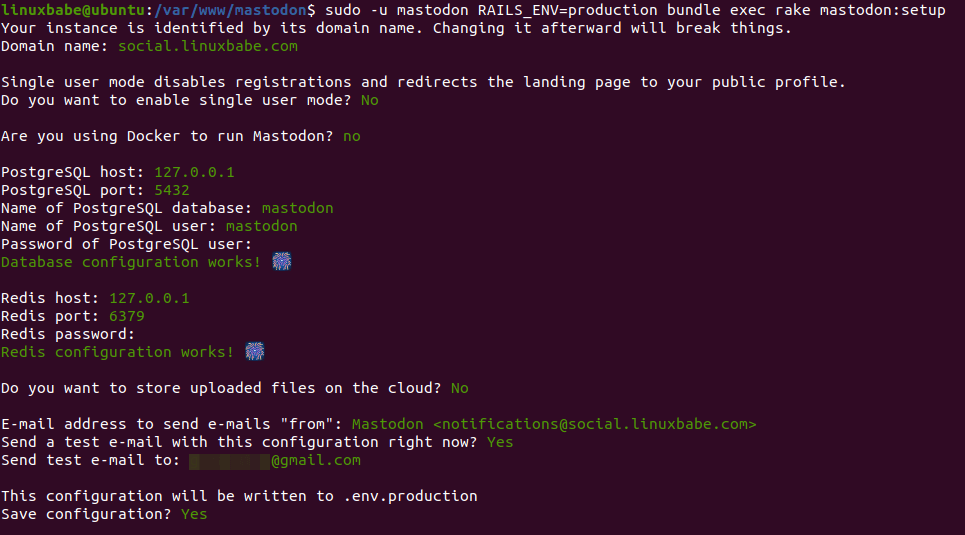
Next, Choose Yes to set up the database.
Now that configuration is saved, the database schema must be loaded. If the database already exists, this will erase its contents. Prepare the database now? y
Finally, choose Yes to compile CSS/JS assets.
The final step is compiling CSS/JS assets. This may take a while and consume a lot of RAM. Compile the assets now? (Y/n) y
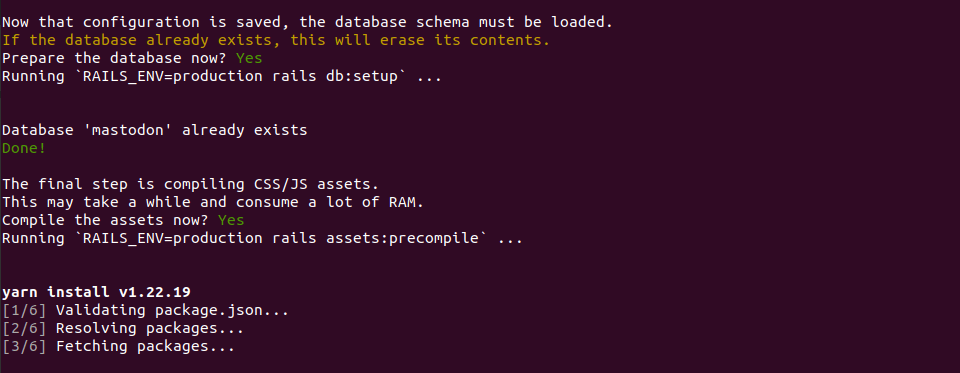
Hint: If Mastodon fails to compile, you should upgrade the server to 2 CPU cores and 3G RAM. If you use Kamatera VPS, it allows you to temporarily upgrade the server CPU and RAM for free without a reboot (Hot Add). Then run the following command again to compile Mastodon CSS/JS assets. Make sure you change back to the original server specs, so Kamatera won’t charge extra dollars for CPU/RAM hot add.
sudo -u mastodon RAILS_ENV=production bundle exec rake mastodon:setup
Once that’s done, you can create an admin user.
Do you want to create an admin user straight away? Yes Username: super_admin E-mail: xiao@linuxbabe.com You can login with the password: 0b8c9359a98059aWg0yhPyVP3eeOn6715eeb
Step 4: Start Mastodon
Mastodon provides convenient systemd service templates. We can copy them to the /etc/sysetmd/system/ directory.
sudo cp /var/www/mastodon/dist/mastodon*.service /etc/systemd/system/
Then we need to make some changes to the .service files. Change the working directory from /home/mastodon/live/ to /var/www/mastodon/.
sudo sed -i 's/home\/mastodon\/live/var\/www\/mastodon/g' /etc/systemd/system/mastodon-*.service
Change /home/mastodon/.rbenv/shims/bundle to /usr/local/bin/bundle.
sudo sed -i 's/home\/mastodon\/.rbenv\/shims/usr\/local\/bin/g' /etc/systemd/system/mastodon-*.service
Reload systemd for the changes to take effect.
sudo systemctl daemon-reload
Start the 3 systemd services.
sudo systemctl enable --now mastodon-web mastodon-sidekiq mastodon-streaming
Check status. Make sure they are all in active (running) state.
sudo systemctl status mastodon-web mastodon-sidekiq mastodon-streaming
Wait a few seconds, then run the following command to check if Mastodon is listing on port 3000.
sudo ss -lnpt | grep 3000
If Mastodon is running properly, it should output:
LISTEN 0 1024 127.0.0.1:3000 0.0.0.0:* users:(("ruby2.7",pid=43543,fd=5),("ruby2.7",pid=43535,fd=5),("ruby2.7",pid=43520,fd=5))
If port 3000 thousand is already taken by another process, you need to edit the /etc/systemd/system/mastodon-web.service file.
sudo nano /etc/systemd/system/mastodon-web.service
Find the following line.
Environment="PORT=3000"
Change the port number like 3001, so Mastodon will be listening on port 3001. Reload systemd and restart Mastodon.
sudo systemctl daemon-reload sudo systemctl restart mastodon-web
Step 5: Configure Nginx Reverse Proxy
Install Nginx web server from the default Ubuntu 24.04 software repository.
sudo apt install nginx
Copy the Nginx template configuration file.
sudo cp /var/www/mastodon/dist/nginx.conf /etc/nginx/conf.d/mastodon.conf
Edit the new file.
sudo nano /etc/nginx/conf.d/mastodon.conf
Find the following line in both the port 80 server block and port 443 server block.
server_name example.com;
Change the server name. Don’t forget to add DNS A record for the domain name.
server_name social.example.com;
Find the following line in both the port 80 server block and port 443 server block.
root /home/mastodon/live/public;
Change it to:
root /var/www/mastodon/public;
Find the following two lines.
# ssl_certificate /etc/letsencrypt/live/example.com/fullchain.pem; # ssl_certificate_key /etc/letsencrypt/live/example.com/privkey.pem;
Change them to the following, so Nginx will tempoarily use a self-signed TLS certificate. We will obtain a valid Let’s Encrypt certificate later.
ssl_certificate /etc/ssl/certs/ssl-cert-snakeoil.pem; ssl_certificate_key /etc/ssl/private/ssl-cert-snakeoil.key;
Save and close the file. Create the cache directory.
sudo mkdir -p /var/nginx/cache/
Then test Nginx configuration.
sudo nginx -t
If the test is successful, reload Nginx for the changes to take effect.
sudo systemctl reload nginx
Now you should be able to see the Mastodon forum at http://social.example.com.
Step 7: Enable HTTPS
To encrypt HTTP traffic, we can enable HTTPS by installing a free TLS certificate issued from Let’s Encrypt. Run the following command to install Let’s Encrypt client (certbot) on Ubuntu 24.04 server.
sudo apt install certbot python3-certbot-nginx
Next, run the following command to obtain and install TLS certificate.
sudo certbot --nginx --agree-tos --redirect --hsts --staple-ocsp --email you@example.com -d social.example.com
Where
--nginx: Use the nginx plugin.--agree-tos: Agree to terms of service.--redirect: Force HTTPS by 301 redirect.--hsts: Add the Strict-Transport-Security header to every HTTP response. Forcing browser to always use TLS for the domain. Defends against SSL/TLS Stripping.--staple-ocsp: Enables OCSP Stapling. A valid OCSP response is stapled to the certificate that the server offers during TLS.--email: an email address is required to receive important email notification for your TLS certificates.
The certificate should now be obtained and automatically installed.
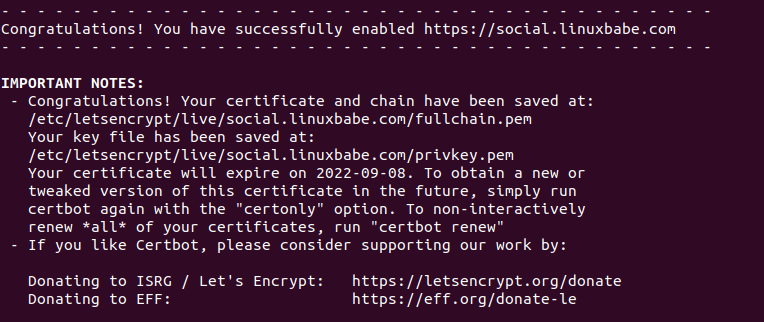
And you can access Mastodon forum via HTTPS (https://social.example.com).

And you can login using the admin account created in step 3. After login, you should change the password.
Hint: My Mastodon account: https://social.linuxbabe.com/@super_admin
Can’t Send Emails?
If Mastodon fails to send emails, you can find out what went wrong by going to the https://social.example.com/sidekiq/retries URL, assuming you are logged in as the admin user.
It will show you the failed emails and why email sending failed.
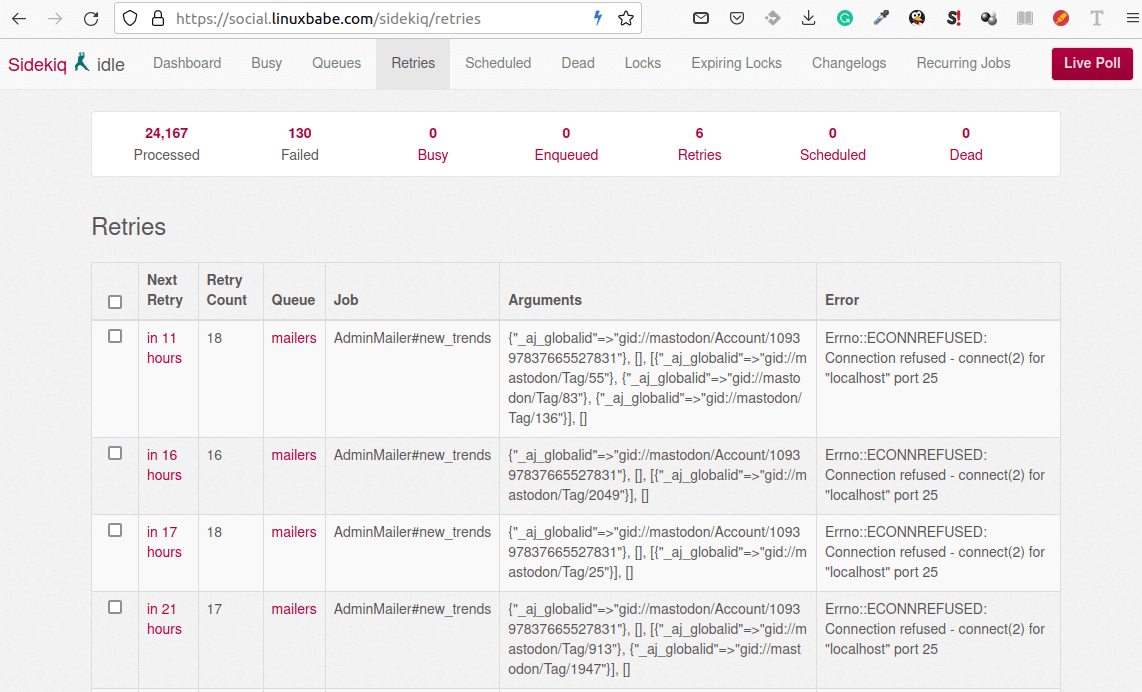
As you can see from the above screenshot, localhost:25 refused connection from my Mastodon installation. It turned out that I moved Mastodon to a bigger server but forgot to set up SMTP relay. Once SMTP relay is configured, email sending is working again.
If there are still problems in SMTP, please check the Postfix mail log file.
sudo tail /var/log/mail.log
or
sudo vim /var/log/mail.log
How to Back Up and Restore Mastodon Database
Dump the database into a tar archive.
sudo -u postgres -i pg_dump -F t mastodon > mastodon_pgsql.tar
Restore the database.
sudo -u postgres -i pg_restore --clean --dbname=mastodon /path/to/the/mastodon_pgsql.tar
If you see the following error during restoration. Ignore it. pg_restore will automatically create the missing database tables (relations).
pg_restore: error: could not execute query: ERROR: relation "public.custom_filters" does not exist
To back up the /var/www/mastodon/ folder, I recommend using Duplicati.
Troubleshooting Mastodon Runtime Error
If the Mastodon web page isn’t working, you should check the sysetmd journals.
sudo journalctl -eu mastodon-web sudo journalctl -eu mastodon-sidekiq sudo journalctl -eu mastodon-streaming
How to Upgrade Mastodon
First, back up the database as mentioned above.
Then go to the Mastodon web root directory.
cd /var/www/mastodon/
Fetch new release tags.
sudo -u mastodon git fetch --tags
Sample output:
* [new tag] v4.2.1 -> v4.2.1 * [new tag] v4.2.2 -> v4.2.2 * [new tag] v4.2.3 -> v4.2.3 * [new tag] v4.2.4 -> v4.2.4 * [new tag] v4.2.5 -> v4.2.5 * [new tag] v4.2.6 -> v4.2.6 * [new tag] v4.2.7 -> v4.2.7 * [new tag] v4.2.8 -> v4.2.8
Upgrade to v4.2.8
sudo -u mastodon git checkout v4.2.8
Migrate the database.
sudo -u mastodon RAILS_ENV=production bundle exec rake db:migrate
Compile the assets.
sudo -u mastodon bundle install -j$(getconf _NPROCESSORS_ONLN) sudo -u mastodon yarn install sudo -u mastodon RAILS_ENV=production bundle exec rails assets:precompile
Migrate the database again.
sudo -u mastodon RAILS_ENV=production bundle exec rake db:migrate
Once that’s done. Restart Mastodon.
sudo systemctl restart mastodon-web mastodon-sidekiq mastodon-streaming
How to Upgrade PostgreSQL Database Server
If psql throws out a warning message like “database "postgres" has a collation version mismatch“, then you need to upgrade PostgreSQL.
The following instructions show how to upgrade from PostgreSQL 15 to PostgreSQL 16 after it’s released. You can also apply this method to upgrade PostgreSQL 16 to 17 when it’s released.
When a new version of PostgreSQL comes out, you can upgrade to take advantage of performance improvements. Simply run the following command, and the apt package manager will install the latest version of PostgreSQL from the apt.postgresql.org repository.
sudo apt update; sudo apt upgrade -y
After that, you also need to upgrade existing PostgreSQL clusters. Pro Tip: You should open a GNU Screen session to prevent connection drop because the upgrade will take some time.
screen
Then list PostgreSQL clusters.
sudo pg_lsclusters
Sample output:
Ver Cluster Port Status Owner Data directory Log file
15 main 5432 online postgres /var/lib/postgresql/15/main /var/log/postgresql/postgresql-15-main.log
16 main 5433 online postgres /var/lib/postgresql/16/main /var/log/postgresql/postgresql-16-main.log
As you can see, PostgreSQL 15 is using the default 5432 port. PostgreSQL 16 is using port 5433. Stop PostgreSQL server.
sudo systemctl stop postgresql
Let’s check the cluster status again with: sudo pg_lsclusters. They are all down.
Ver Cluster Port Status Owner Data directory Log file
15 main 5432 down postgres /var/lib/postgresql/15/main /var/log/postgresql/postgresql-15-main.log
16 main 5433 down postgres /var/lib/postgresql/16/main /var/log/postgresql/postgresql-16-main.log
Rename the cluster name of PostgreSQL 16 from main to latest_stable.
sudo pg_renamecluster 16 main latest_stable
Next, upgrade the old PostgreSQL 15 cluster. This works by copying the databases from /var/lib/postgresql/15/main/ directory to the /var/lib/postgresql/16/main/ directory with pg_dump and pg_restore. Database configuration files will also be copied.
sudo pg_upgradecluster 15 main
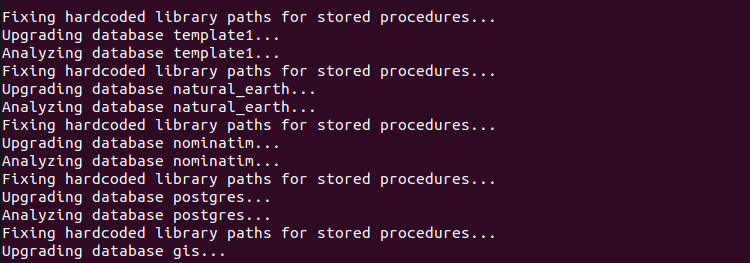
Start PostgreSQL server.
sudo systemctl start postgresql
Now check if your application is working. If it’s working well, then drop the old cluster.
sudo pg_dropcluster 15 main
Check cluster status again:
sudo pg_lsclusters
Conclusion
I hope this article helped you install Mastodon forum software on Ubuntu 24.04. As always, if you found this post useful, then subscribe to our free newsletter to get more tips and tricks. Take care 🙂



Unlocking the Efficient Path of SMT PCB Assembly: Enhance Your Electronic Product Competitiveness
In the field of electronic manufacturing, SMT (Surface Mount Technology) PCB assembly is key to improving product performance and reducing costs. With precise automation equipment, SMT technology enables high-speed, high-precision placement of electronic components, ensuring product reliability and durability. As technology continues to advance, SMT PCB assembly not only boosts production efficiency but also facilitates the miniaturization and multifunctionality of electronic products. For companies striving for excellence in quality and performance, adopting SMT PCB assembly technology is undoubtedly a smart choice to enhance market competitiveness. Let’s explore how SMT PCB assembly can bring revolutionary changes to your electronic products. For more details, please visit our website https://gekunflex.com/pcb-assembly/
You went from Step 5 to Step 7. You skipped step 6.
Xiao are you still around ?
listens on 200 rather than 244 does it matter?
LISTEN 0 200 127.0.0.1:5432 0.0.0.0:* users:((“postgres”,pid=9002,fd=6))
Going from top to bottom on a fresh new install 24.04 Ubuntu…
all the way down to:
sudo -u mastodon yarn install
KICKS OUT THIS:
error This project’s package.json defines “packageManager”: “yarn@4.5.0”. However the current global version of Yarn is 1.22.22.
Presence of the “packageManager” field indicates that the project is meant to be used with Corepack, a tool included by default with all official Node.js distributions starting from 16.9 and 14.19.
Corepack must currently be enabled by running corepack enable in your terminal. For more information, check out https://yarnpkg.com/corepack.
SO MAYBE AFTER:
sudo -u mastodon yarn install
SHOULD INCLUDE:
corepack enable
THEN:
sudo -u mastodon yarn install
WHICH KICKS OUT:
node:fs:1391
handleErrorFromBinding(ctx);
^
Error: EACCES: permission denied, mkdir ‘/nonexistent/.cache/node/corepack/v1’
at mkdirSync (node:fs:1391:3)
at getTemporaryFolder (/usr/lib/node_modules/corepack/dist/lib/corepack.cjs:21486:27)
at download (/usr/lib/node_modules/corepack/dist/lib/corepack.cjs:21760:21)
at installVersion (/usr/lib/node_modules/corepack/dist/lib/corepack.cjs:21854:61)
at async Engine.ensurePackageManager (/usr/lib/node_modules/corepack/dist/lib/corepack.cjs:22310:32)
at async Engine.executePackageManagerRequest (/usr/lib/node_modules/corepack/dist/lib/corepack.cjs:22410:25)
at async Object.runMain (/usr/lib/node_modules/corepack/dist/lib/corepack.cjs:23096:5) {
errno: -13,
syscall: ‘mkdir’,
code: ‘EACCES’,
path: ‘/nonexistent/.cache/node/corepack/v1’
}
Node.js v18.20.6
PERMISSION DENIED ON ROOT?
PLEASE ADVISE
corepack enable
yarn set version classic
JUST FYI THAT WAS AMENDING TO THE CURRENT VERSION 4.3.3 AS OF 2.11.2025
OK NEW FRESH INSTALL AGAIN:
FOLLOWING WITHOUT ANY MODIFICATIONS WHATSOEVER.
GET ALL THE WAY TO:
sudo -u mastodon yarn install
THIS GOES THROUGH AND AT THE END STATES:
yarn install v1.22.22
warning Skipping preferred cache folder “/nonexistent/.cache/yarn” because it is not writable.
warning Selected the next writable cache folder in the list, will be “/tmp/.yarn-cache-111”.
[1/6] Validating package.json…
[2/6] Resolving packages…
[3/6] Fetching packages…
warning Pattern [“strip-ansi@^6.0.1”] is trying to unpack in the same destination “/tmp/.yarn-cache-111/v6/npm-strip-ansi-cjs-6.0.1-9e26c63d30f53443e9489495b2105d37b67a85d9-integrity/node_modules/strip-ansi-cjs” as pattern [“strip-ansi-cjs@npm:strip-ansi@^6.0.1”]. This could result in non-deterministic behavior, skipping.
warning Pattern [“string-width@^4.1.0”] is trying to unpack in the same destination “/tmp/.yarn-cache-111/v6/npm-string-width-cjs-4.2.3-269c7117d27b05ad2e536830a8ec895ef9c6d010-integrity/node_modules/string-width-cjs” as pattern [“string-width-cjs@npm:string-width@^4.2.0”]. This could result in non-deterministic behavior, skipping.
warning Pattern [“strip-ansi@^6.0.0”] is trying to unpack in the same destination “/tmp/.yarn-cache-111/v6/npm-strip-ansi-cjs-6.0.1-9e26c63d30f53443e9489495b2105d37b67a85d9-integrity/node_modules/strip-ansi-cjs” as pattern [“strip-ansi-cjs@npm:strip-ansi@^6.0.1”]. This could result in non-deterministic behavior, skipping.
warning Pattern [“string-width@^4.2.3”] is trying to unpack in the same destination “/tmp/.yarn-cache-111/v6/npm-string-width-cjs-4.2.3-269c7117d27b05ad2e536830a8ec895ef9c6d010-integrity/node_modules/string-width-cjs” as pattern [“string-width-cjs@npm:string-width@^4.2.0”]. This could result in non-deterministic behavior, skipping.
warning Pattern [“string-width@^1.0.2 || 2 || 3 || 4”] is trying to unpack in the same destination “/tmp/.yarn-cache-111/v6/npm-string-width-cjs-4.2.3-269c7117d27b05ad2e536830a8ec895ef9c6d010-integrity/node_modules/string-width-cjs” as pattern [“string-width-cjs@npm:string-width@^4.2.0”]. This could result in non-deterministic behavior, skipping.
warning Pattern [“string-width@^4.2.0”] is trying to unpack in the same destination “/tmp/.yarn-cache-111/v6/npm-string-width-cjs-4.2.3-269c7117d27b05ad2e536830a8ec895ef9c6d010-integrity/node_modules/string-width-cjs” as pattern [“string-width-cjs@npm:string-width@^4.2.0”]. This could result in non-deterministic behavior, skipping.
warning Pattern [“wrap-ansi@^7.0.0”] is trying to unpack in the same destination “/tmp/.yarn-cache-111/v6/npm-wrap-ansi-cjs-7.0.0-67e145cff510a6a6984bdf1152911d69d2eb9e43-integrity/node_modules/wrap-ansi-cjs” as pattern [“wrap-ansi-cjs@npm:wrap-ansi@^7.0.0″]. This could result in non-deterministic behavior, skipping.
[4/6] Linking dependencies…
warning ” > emoji-mart@3.0.1-j” has incorrect peer dependency “react@^0.14.0 || ^15.0.0-0 || ^16.0.0 || ^17.0.0″.
warning ” > react-motion@0.5.2″ has incorrect peer dependency “react@^0.14.9 || ^15.3.0 || ^16.0.0″.
warning ” > react-notification@6.8.5″ has incorrect peer dependency “react@^0.14.0 || ^15.0.0 || ^16.0.0″.
warning ” > react-router-scroll-4@1.0.0-beta.2″ has incorrect peer dependency “react@^15.0.0 || ^16.0.0″.
warning ” > react-router-scroll-4@1.0.0-beta.2″ has incorrect peer dependency “react-dom@^15.0.0 || ^16.0.0″.
warning ” > react-swipeable-views@0.14.0″ has incorrect peer dependency “react@^15.3.0 || ^16.0.0 || ^17.0.0”.
warning “react-swipeable-views > react-swipeable-views-utils > react-event-listener@0.6.6” has incorrect peer dependency “react@^16.3.0”.
[5/6] Building fresh packages…
⠁
⠁
⠁
⠁
warning Cannot find a suitable global folder. Tried these: “/usr/local, /nonexistent/.yarn”
[6/6] Cleaning modules…
$ husky install
warning Cannot find a suitable global folder. Tried these: “/usr/local, /nonexistent/.yarn”
husky – Git hooks installed
Done in 40.11s.
Error: ENOENT: no such file or directory, open ‘/nonexistent/.yarnrc’
SO NOW WHAT? ; )
**** REBOOTED THE SERVER *****
ATTEMPTED AGAIN:
sudo -u mastodon yarn install
yarn install v1.22.22
warning Skipping preferred cache folder “/nonexistent/.cache/yarn” because it is not writable.
warning Selected the next writable cache folder in the list, will be “/tmp/.yarn-cache-111”.
[1/6] Validating package.json…
[2/6] Resolving packages…
success Already up-to-date.
$ husky install
warning Cannot find a suitable global folder. Tried these: “/usr/local, /nonexistent/.yarn”
husky – Git hooks installed
Done in 0.65s.
Error: ENOENT: no such file or directory, open ‘/nonexistent/.yarnrc’
THAT’S IT UNTIL WE HERE BACK FROM LINUXBABE!
**** IT IS POSSIBLE *******
● mastodon-web.service – mastodon-web
Loaded: loaded (/etc/systemd/system/mastodon-web.service; enabled; preset: enabled)
Active: active (running) since Wed 2025-02-12 17:21:20 UTC; 1 day 4h ago
Main PID: 3684 (ruby3.2)
Tasks: 29 (limit: 3485)
Memory: 457.0M (peak: 457.3M)
CPU: 19.825s
CGroup: /system.slice/mastodon-web.service
├─ 3684 “puma 6.4.2 (tcp://127.0.0.1:3000) [mastodon]”
├─ 3711 “puma: cluster worker 0: 3684 [mastodon]”
└─35440 “puma: cluster worker 1: 3684 [mastodon]”
Feb 13 21:48:34 mail.theamericans.us bundle[3711]: I, [2025-02-13T21:48:34.074874 #3711] INFO — : [627b5706>
Feb 13 21:48:35 mail.theamericans.us bundle[35440]: I, [2025-02-13T21:48:35.143008 #35440] INFO — : [2bc088>
Feb 13 21:48:35 mail.theamericans.us bundle[35440]: I, [2025-02-13T21:48:35.194989 #35440] INFO — : [a182b3>
Feb 13 21:48:35 mail.theamericans.us bundle[3711]: I, [2025-02-13T21:48:35.910478 #3711] INFO — : [a1e36440>
Feb 13 21:48:37 mail.theamericans.us bundle[35440]: I, [2025-02-13T21:48:37.299708 #35440] INFO — : [3c0e12>
Feb 13 21:48:40 mail.theamericans.us bundle[3711]: I, [2025-02-13T21:48:40.812530 #3711] INFO — : [bf4c6f4c>
Feb 13 21:48:40 mail.theamericans.us bundle[35440]: I, [2025-02-13T21:48:40.868788 #35440] INFO — : [71c4aa>
Feb 13 21:48:43 mail.theamericans.us bundle[35440]: I, [2025-02-13T21:48:43.760808 #35440] INFO — : [829fc9>
Feb 13 21:48:46 mail.theamericans.us bundle[35440]: I, [2025-02-13T21:48:46.058206 #35440] INFO — : [00cb0b>
Feb 13 21:48:46 mail.theamericans.us bundle[3711]: I, [2025-02-13T21:48:46.132013 #3711] INFO — : [0f05b9ef>
● mastodon-sidekiq.service – mastodon-sidekiq
Loaded: loaded (/etc/systemd/system/mastodon-sidekiq.service; enabled; preset: enabled)
Active: active (running) since Wed 2025-02-12 17:06:23 UTC; 1 day 4h ago
Main PID: 743 (ruby3.2)
Tasks: 42 (limit: 3485)
Memory: 336.3M (peak: 342.2M)
CPU: 2min 54.118s
CGroup: /system.slice/mastodon-sidekiq.service
└─743 “sidekiq 6.5.12 mastodon [0 of 25 busy]”
Feb 13 21:51:33 mail.theamericans.us bundle[743]: 2025-02-13T21:51:33.396Z pid=743 tid=2l0r class=Scheduler::>
Feb 13 21:51:37 mail.theamericans.us bundle[743]: 2025-02-13T21:51:37.886Z pid=743 tid=2j5r INFO: queueing Sc>
Feb 13 21:51:37 mail.theamericans.us bundle[743]: 2025-02-13T21:51:37.887Z pid=743 tid=2knb INFO: queueing Sc>
Feb 13 21:51:37 mail.theamericans.us bundle[743]: 2025-02-13T21:51:37.887Z pid=743 tid=2ngj INFO: queueing Sc>
Feb 13 21:51:37 mail.theamericans.us bundle[743]: 2025-02-13T21:51:37.890Z pid=743 tid=2kwz class=Scheduler::>
Feb 13 21:51:37 mail.theamericans.us bundle[743]: 2025-02-13T21:51:37.891Z pid=743 tid=2lyz class=Scheduler::>
Feb 13 21:51:37 mail.theamericans.us bundle[743]: 2025-02-13T21:51:37.892Z pid=743 tid=2jxj class=Scheduler::>
Feb 13 21:51:37 mail.theamericans.us bundle[743]: 2025-02-13T21:51:37.894Z pid=743 tid=2jxj class=Scheduler::>
Feb 13 21:51:37 mail.theamericans.us bundle[743]: 2025-02-13T21:51:37.896Z pid=743 tid=2lyz class=Scheduler::>
Feb 13 21:51:37 mail.theamericans.us bundle[743]: 2025-02-13T21:51:37.898Z pid=743 tid=2kwz class=Scheduler::>
● mastodon-streaming.service – mastodon-streaming
Loaded: loaded (/etc/systemd/system/mastodon-streaming.service; enabled; preset: enabled)
Active: active (exited) since Wed 2025-02-12 17:06:24 UTC; 1 day 4h ago
Main PID: 745 (code=exited, status=0/SUCCESS)
CPU: 1ms
NOW JUST TRYING TO FIGURE OUT THE CLI
WORKING AND IT TOOK ABOUT THREE DAYS TO FIGURE THIS ALL OUT….
THANKS LINUXBABE!